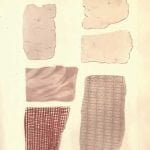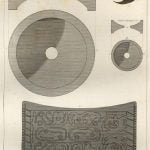
The Islanders of the Pacific Ocean fabricate a species of cloth, or habilimental tapestry, from the fibrous inner bark of certain trees. This bark is macerated, and extended into a comparatively thin surface by mallets of wood or stone. When the required degree of attenuation has been attained, the pieces are dyed, or colored with certain pigments, or vegetable concoctions, known to them. To impart regularity to the patterns, blocks or prints are applied. The coloring is wholly external; in no instance, of many specimens examined, does it extend through, or on both sides of the bark. A proof entirely conclusive that it has not been dipped, or immersed in a vat. It is not easy to determine whether a mordant has been used to set the dye or decoction. From several specimens from the Owyhee, or Sandwich Island group, herewith figured, in Plate 30, Figures 4, 5, and 6,) which have been deposited in our cabinet for upwards of twenty years, the coloring matter appears to be quite permanent. It has, at least, resisted the rays of light, with but little change, during that period; but it must be remarked that the specimens have been protected, a part of the time, in drawers. It will be observed that the yellows and blacks have endured best. A carmine-red has endured tolerably; a light brick red exhibits no change.


From a specimen of this Polynesian bark now before us, it appears to possess an alkaline property, which gives it some of the qualities of felt. It is fibrous and tubercular. Long keeping, in a dry place, has developed spongy spots.
This art of cloth-making for summer garments appears to be confined to the tribes of Polynesia; but the natives of Mexico and Peru, who had the cotton plant, perhaps the mien kwa of the Chinese, and made garments from it, used the block-print to figure it. Traces of this art appear recently to have been found among the antiquities of the Mississippi Valley.
One of these blocks, herewith figured in Plate 23, Fig. 5, was disinterred from a mound in the city plot of Cincinnati in 1841. It is described and figured in the second volume, page 195, of the Western Pioneer. It is a stone, whose species is not described.
Another was discovered by the writer, in the collection preserved in 1844, at the great mound of the Grave Creek flats, and is figured in Plate 29, Figs. 1 and 2, and described in the first volume of the Transactions of the American Ethnological Society, page 400. It was found in one of the minor mounds of those flats. It is a species of yellowish sandstone.
